Kapaleeshwarar Temple Mylapore
The Kapaleeshwarar Temple is a Hindu temple dedicated to the god Shiva, located in Mylapore, Chennai, in the Indian state of Tamil Nadu. It is an example of Dravidian architecture, with towering gopurams (gateway towers) that are characteristic of South Indian temples.
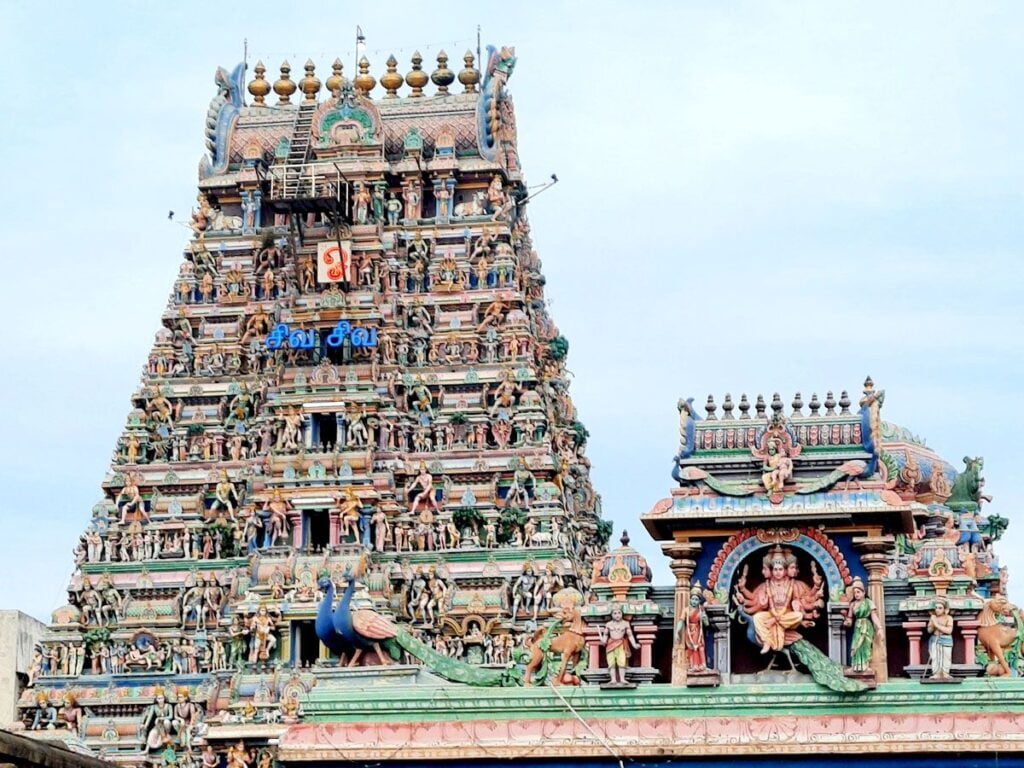
Contents
- 1 Kapaleeshwarar Temple History:
- 2 Legend of Kapaleeshwarar Temple:
- 3 Significance of Kapaleeshwarar Temple:
- 4 Myths and beliefs of Kapaleeshwarar Temple:
- 5 Architecture of Kapaleeshwarar Temple:
- 6 Kapaleeshwarar Temple Timing and Rituals:
- 7 Places to visit near Kapaleeshwarar Temple:
- 8 FAQ:
- 9 How to reach Kapaleeshwarar Temple:
- 10 Google Maps:
Kapaleeshwarar Temple History:
Origins and Early History
The temple’s origins are believed to date back to the 7th century CE, though there is evidence suggesting an even earlier existence. References to the temple are found in the hymns of the Nayanar saints, a group of 63 Shaivaite saints from the 6th to the 9th centuries. Additionally, inscriptions dating back to the 12th century have been found within the temple complex.
According to Hindu legend, the name “Mylapore” comes from the Tamil word “mayil,” meaning “peacock.” The legend states that Parvati, the consort of Shiva, once took the form of a peahen to worship Shiva here.
The temple is considered to be one of the most sacred Shiva temples in South India and is revered by Shaivites, or devotees of Shiva. It is one of the 275 Paadal Petra Sthalams, the revered Shiva temples glorified in the Tamil hymns of the Nayanars and the Appar.
Later History and Renovations
The temple complex has undergone several renovations and additions over the centuries. The 120-foot gopuram (gateway tower) was built in 1906. The temple is currently maintained and administered by the Hindu Religious and Endowment Board of the Government of Tamil Nadu.
Key Features of the Temple
The temple complex is vast and encompasses numerous shrines, halls, and corridors. Some of the key features include:
- The Kapaleeshwarar shrine: This is the main sanctum of the temple, housing the Shiva lingam, the representation of Shiva.
- The Karpagambal shrine: This shrine is dedicated to Parvati, who is worshipped as Karpagambal, the goddess of the wish-yielding tree.
- The halls: The temple complex has several halls, including the thousand-pillar hall (Aayi Mandapam) and the hall of sculptures.
- The sacred tank: The temple complex has a large sacred tank, which is believed to have healing properties.
Read More>> Karpaga Vinayagar Temple Pillayarpatti – 5th century Temple
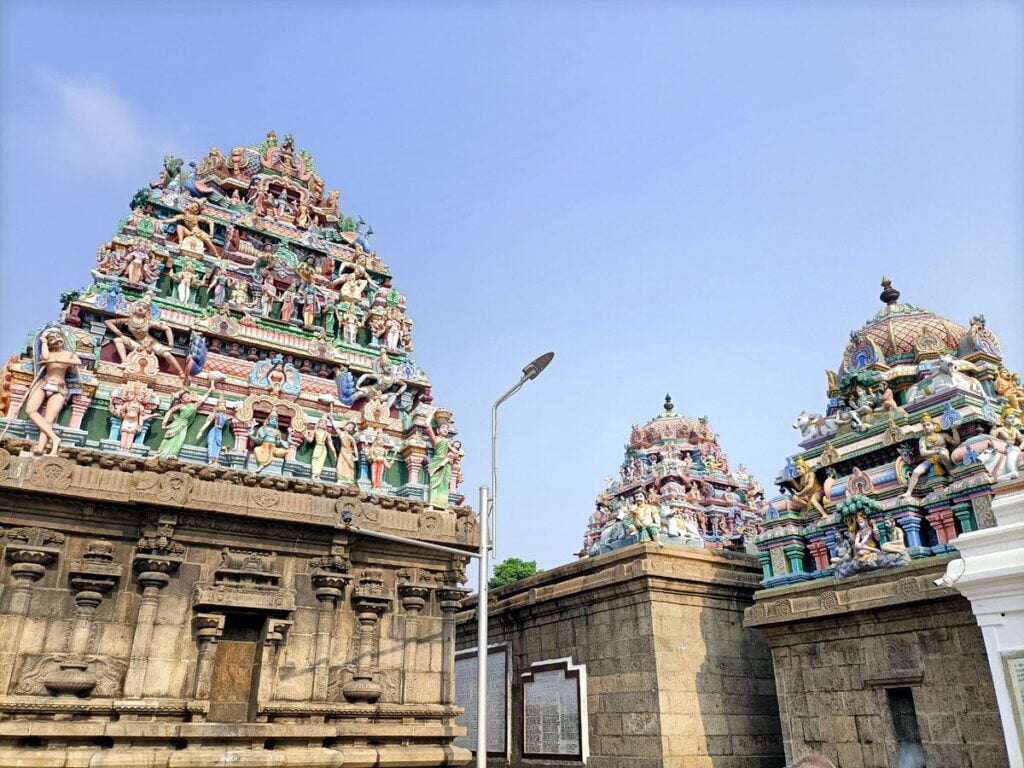
Legend of Kapaleeshwarar Temple:
1. The legend of Brahma’s fifth head:
According to the Puranas, a disagreement arose between Lord Brahma, the creator, and Lord Shiva, the destroyer, regarding their superiority. Filled with pride, Brahma boasted about his five heads, each representing a Veda (ancient Hindu scripture). To teach him humility, Shiva severed one of Brahma’s heads. The severed head, or “kapala” in Sanskrit, remained stuck to Shiva’s hand, earning him the name Kapaleeshwarar (meaning “Lord with the skull”).
2. The legend of Parvati as a peahen:
Another legend narrates the story of Parvati, Shiva’s consort. While listening to Shiva explain the significance of a sacred mantra, Parvati became distracted by a beautiful peacock. Angered by her lack of attention, Shiva cursed Parvati to transform into a peahen and perform penance at this very spot. The place came to be known as Mylapore, derived from the Tamil word “mayil,” meaning “peahen.” Parvati, as a peahen, eventually appeased Shiva and regained her original form.
Read More>> Thanumalayan Temple Suchindram
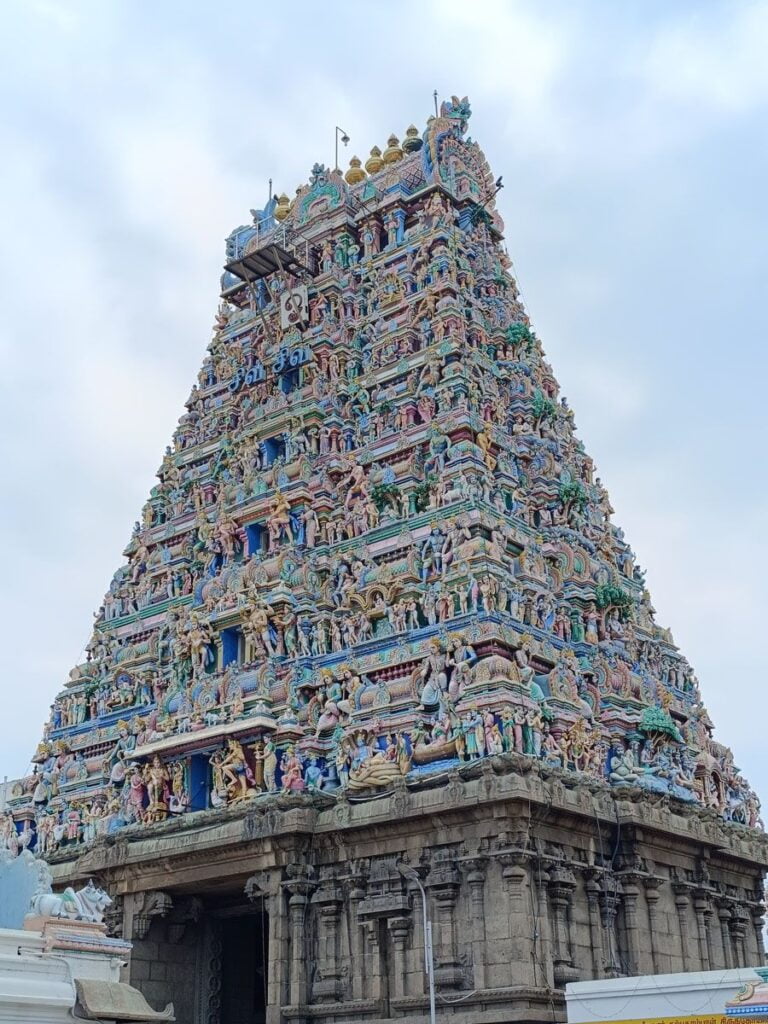
Significance of Kapaleeshwarar Temple:
Historical Significance:
- Dating back to the 7th century CE, the temple is an embodiment of South Indian architecture and cultural heritage.
- It finds mention in the 7th-century Tamil Shaiva canonical work, the Tevaram, composed by the Nayanmars, highlighting its historical standing.
- The temple complex has undergone various additions and renovations over the centuries, reflecting the changing times and continuous devotion of the people.
Religious Significance:
- Dedicated to Lord Shiva, the temple is revered by Shaivites, especially those following the Tamil Shaiva tradition.
- Lord Shiva is worshipped as Kapaleeshwarar, meaning “Lord of the Skull,” representing his transformative power.
- Goddess Parvati is worshipped as Karpagambal, meaning “giver of wishes,” signifying her benevolence and abundance.
- The temple houses numerous shrines, including those dedicated to the 63 Nayanmars, who hold a special place in the hearts of Tamil Shaivites.
Cultural Significance:
- The Kapaleeshwarar Temple is a vibrant center of Tamil culture and tradition.
- It is a place where people from all walks of life come together to celebrate their faith, participate in rituals, and experience the rich cultural heritage of Tamil Nadu.
- The temple hosts several festivals throughout the year, with the Arupatimoovar festival being the most prominent, attracting thousands of devotees.
Read More>> Brihadeeswarar Temple: Timeless Marvel of Chola Architecture
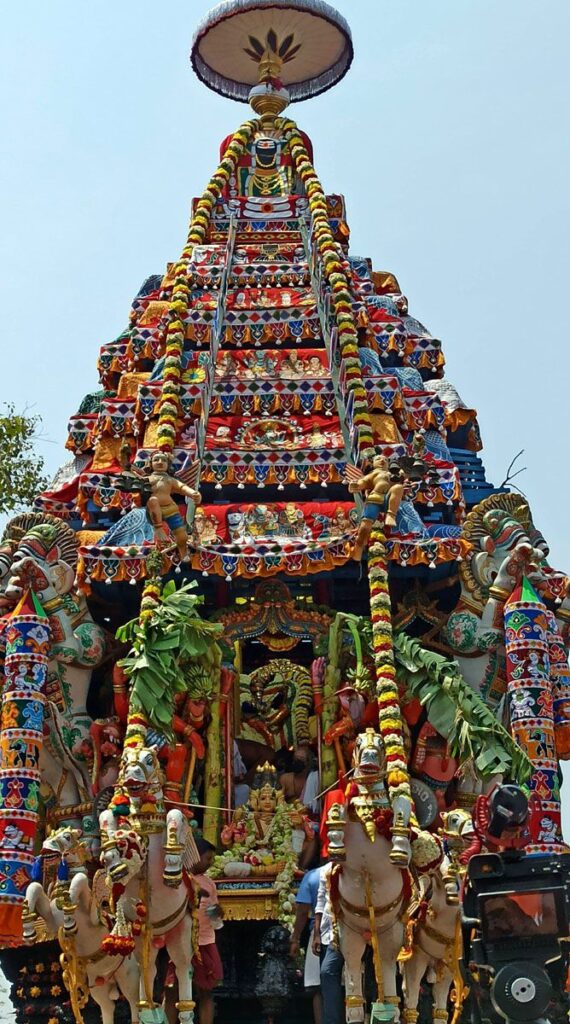
Myths and beliefs of Kapaleeshwarar Temple:
1. The legend of Shiva and Parvati:
- The temple is believed to be the place where Lord Shiva performed his celestial dance (Tandava) to liberate a group of saints from their ignorance.
- Another legend narrates that it was here that Parvati, in the form of Katyayani, performed severe penance to win Shiva’s hand in marriage.
2. The story of Saint Pattinathar:
- Saint Pattinathar, a revered Shaivite saint, is said to have attained enlightenment and merged with the form of the Shivalinga here.
- His image is prominently displayed within the temple complex, reflecting his association with the site.
3. Significance of the location:
- The temple’s location on the banks of the Bay of Bengal is considered sacred. It is believed that a dip in the holy water here washes away sins and brings blessings.
4. The myth of the five elements:
- The temple is believed to represent the five elements (Panchaboothas) – earth, water, fire, air, and space.
- The presence of the sea, the holy water tank, the eternal lamp, the spacious halls, and the earth on which the temple is built, embody these elements.
5. Beliefs associated with rituals:
- Performing puja (worship) at the Kapaleeshwarar Temple is believed to bring prosperity, peace, and liberation.
- Specific rituals like offering prayers during Rahu Kaalam (considered an astrologically inauspicious time) are believed to ward off evil and negative influences.
Read More>> Ranganathaswamy Temple Srirangam
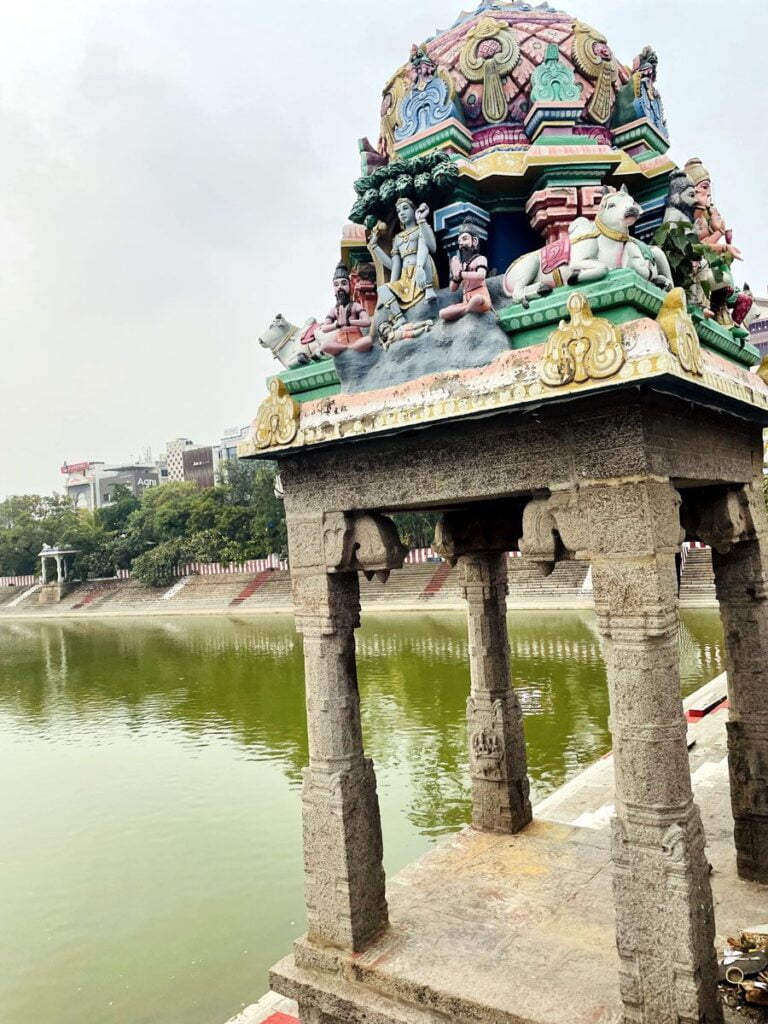
Architecture of Kapaleeshwarar Temple:
- Gopurams: The temple has two main gopurams, the eastern gopuram reaching a height of about 40 meters. These gopurams are adorned with colorful sculptures depicting various Hindu deities and stories.
- Mandapas (halls): The temple complex has several mandapas, each with a unique architectural style. These halls serve as gathering places for devotees and are often used for religious ceremonies.
- Shrines: The temple houses numerous shrines dedicated to various Hindu deities, including the main sanctum sanctorum (innermost shrine) housing the Shiva lingam. Each shrine has its own unique design and ornamentation.
- Tank: The temple complex also includes a sacred tank, known as the “Kapaleeshwarar Temple tank,” which is believed to have healing properties.
Read More>> Ekambeswarar Temple, Kumbakonam
Kapaleeshwarar Temple Timing and Rituals:
Timing:
- Morning: 5:00 AM to 12:00 PM
- Evening: 4:00 PM to 9:30 PM (or 8:30 PM according to some sources)
Please note: The temple remains closed between 12:30 PM and 4:00 PM.
Kapaleeshwarar Temple Rituals:
The Kapaleeshwarar Temple follows six daily rituals, also known as pujas. These rituals are performed at the following times:
- Ushathkalam: 6:00 AM
- Kalasanthi: 9:00 AM
- Uchikalam: 1:00 PM
- Sayarakshai: 5:00 PM
- Irandamkalam: 7:00 PM
- Ardha Jamam: 9:00 PM
Each puja involves four steps:
- Abhisheka: Sacred bath with various elements like milk, curd, honey, and panchamruta (a mixture of five ingredients: milk, curd, ghee, honey, and sugar).
- Alangaram: Decoration of the deities with flowers and ornaments.
- Neivethanam: Offering of food to the deities.
- Deepa aradanai: Waving of lamps filled with ghee or oil in front of the deities.
Read More>> Amirthakadeswarar Temple Sakkottai | 7th CE Padal Petra Temple
Kapaleeswarar Temple Official Website:
It’s recommended to check the official website or call the temple for the most up-to-date timings: https://mylaikapaleeswarar.hrce.tn.gov.in/
Places to visit near Kapaleeshwarar Temple:
- Mylapore Tank: Right next to the Kapaleeshwarar Temple, this tank (pond) provides a serene atmosphere and is a good place for a leisurely stroll.
- Santhome Basilica: Located a short distance away, the Santhome Basilica is a historic church built over the tomb of St. Thomas, one of the twelve apostles of Jesus Christ.
- MGR Film City: If you’re interested in the film industry, MGR Film City offers a glimpse into the world of Tamil cinema. It’s not far from Mylapore and could be an interesting visit.
- Government Museum: The Government Museum, located in Egmore, Chennai, is one of the oldest museums in India. It houses an extensive collection of art, archaeology, and natural history.
- Marina Beach: Chennai’s famous Marina Beach is not too far from Mylapore. It’s a great place for a relaxing walk along the coastline and enjoying the sea breeze.
- Fort St. George: Explore the historical Fort St. George, the first English fortress in India. It houses the St. Mary’s Church, the oldest Anglican church in India.
- Valluvar Kottam: This monument is dedicated to the classical Tamil poet Thiruvalluvar. It’s an architectural marvel and a cultural landmark in Chennai.
- Chetpet Ecopark: For some greenery and outdoor activities, you can visit Chetpet Ecopark. It’s a nice place for a family picnic or a peaceful walk.
- Kapaleeshwarar Temple Tank: Apart from the Mylapore Tank, you can also visit the temple tank associated with the Kapaleeshwarar Temple itself.
- Semmozhi Poonga: This botanical garden in the heart of Chennai offers a beautiful collection of plants and serves as a peaceful retreat from the city buzz.
Read More>> Rajagopalaswamy Temple Mannargudi: 10th CE Famous Dakshina Dwaraka
FAQ:
- What is Kapaleeshwarar Temple?
- Kapaleeshwarar Temple is a Hindu temple dedicated to Lord Shiva located in Mylapore, Chennai, India. It is one of the oldest temples in the city, with a rich history and cultural significance.
- What is the history of Kapaleeshwarar Temple?
- The temple’s origin dates back to the 7th century CE. It has undergone several renovations and expansions over the centuries. The current structure is believed to have been built during the Vijayanagar Empire.
- Who is the main deity of the temple?
- The main deity is Lord Shiva, worshipped in the form of Kapaleeshwarar. The temple also houses a shrine dedicated to Goddess Parvati, known as Karpagambal.
- What is the significance of the name “Kapaleeshwarar”?
- The name “Kapaleeshwarar” is derived from two words: “Kapalam,” meaning skull, and “Ishwara,” meaning Lord. It is believed that Lord Shiva took the form of Kapaleeshwarar after severing the fifth head of Brahma, and hence the name.
- What are the major festivals celebrated at Kapaleeshwarar Temple?
- The temple hosts several festivals throughout the year, including the Arupathimoovar festival, Panguni Uthiram, and Brahmotsavam. The Arupathimoovar festival is a significant event where the processional deities of 63 Nayanars (saints) are taken in a grand procession.
- Can non-Hindus visit the temple?
- Yes, non-Hindus are allowed to visit Kapaleeshwarar Temple. However, visitors are expected to follow the temple’s rules and traditions, such as removing footwear before entering the sanctum sanctorum and maintaining the sanctity of the premises.
- What are the temple timings?
- The temple is usually open from early morning to late evening. However, specific timings may vary on festival days and special occasions. It is recommended to check the official temple website or contact the temple authorities for the latest information.
- Is there an entry fee to visit Kapaleeshwarar Temple?
- Typically, there is no entry fee for general darshan. However, some special rituals or areas may have separate charges. Donations for temple maintenance are encouraged.
- Are photography and videography allowed inside the temple?
- Generally, photography and videography are not allowed inside the sanctum sanctorum. However, visitors may be allowed to take pictures in other areas of the temple. It’s advisable to check with the temple authorities for specific guidelines.
- Is there parking available near the temple?
- Yes, there are parking facilities available near the temple. Visitors can use these facilities to park their vehicles conveniently.
How to reach Kapaleeshwarar Temple:
By Air:
- Chennai International Airport (MAA):
- The nearest airport is Chennai International Airport.
- After arriving at the airport, you can hire a taxi or use ride-sharing services to reach Kapaleeshwarar Temple. It’s approximately 16 kilometers away, and the journey takes around 30-40 minutes depending on traffic.
By Train:
- Chennai Central Railway Station:
- If you are arriving by train, Chennai Central is the main railway station in the city.
- From there, you can hire a taxi, use ride-sharing services, or take public transportation to reach Kapaleeshwarar Temple.
By Bus:
- Chennai Mofussil Bus Terminus (CMBT):
- If you are traveling by bus, CMBT is the main bus station in Chennai.
- From CMBT, you can take a bus or use other modes of transportation to reach Kapaleeshwarar Temple.
